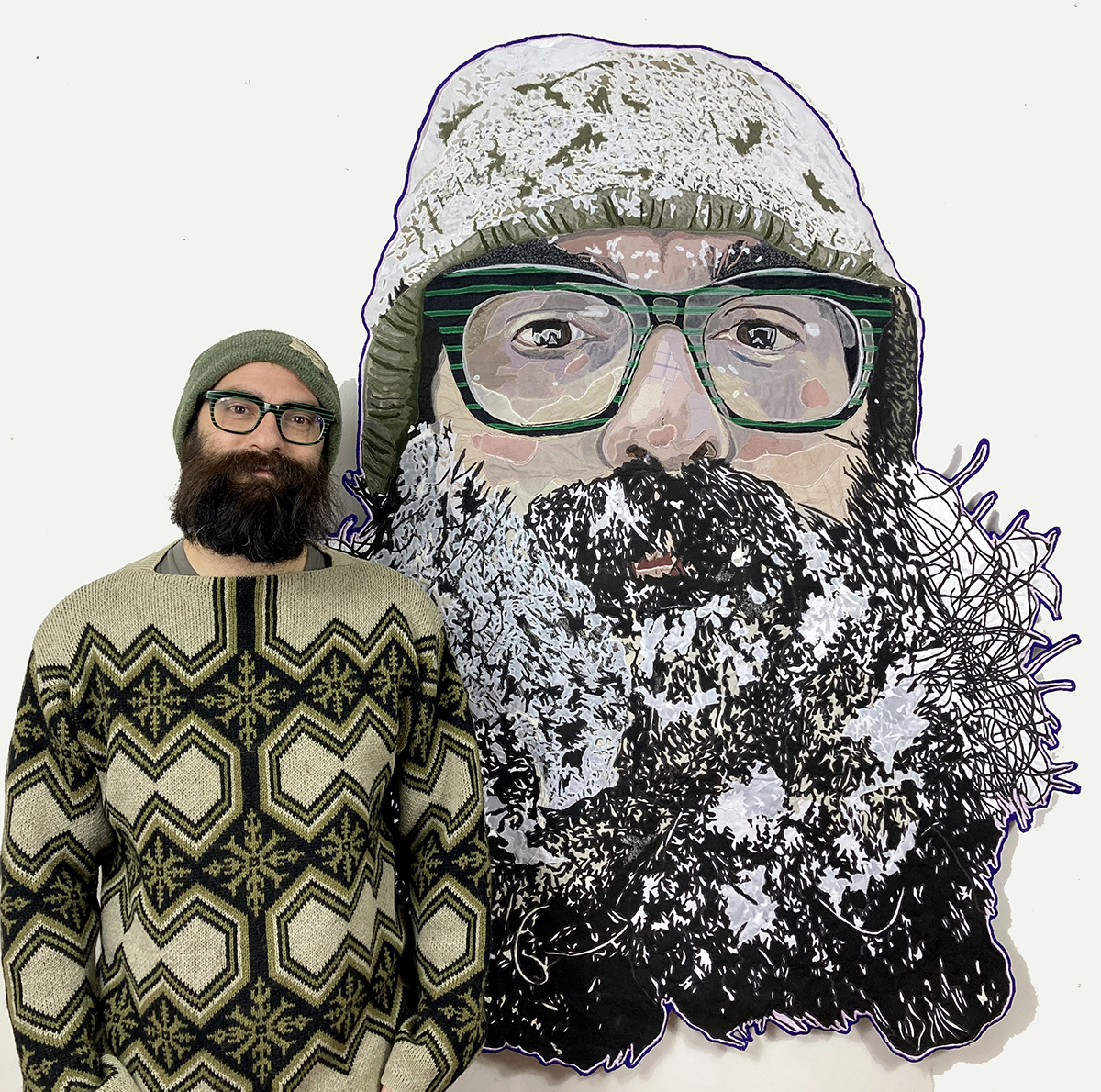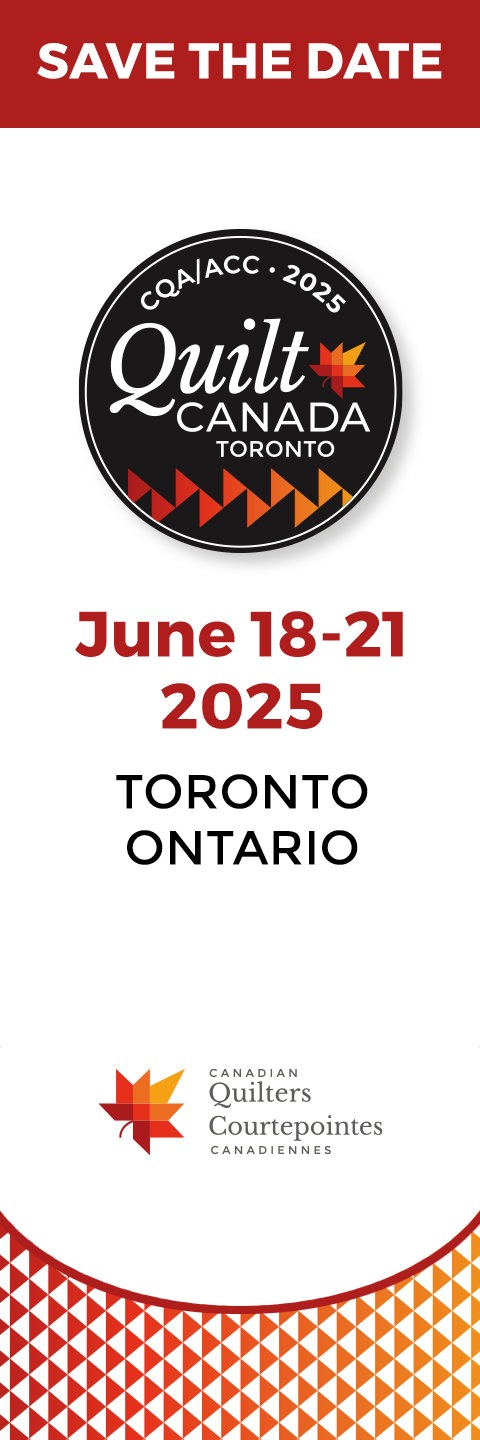I am a self-taught artist. After finishing university, I started painting in my basement. My works have always blurred the lines of a medium, incorporating elements of collage, photography, printmaking, sculpture, ceramics, and textiles.
Figures have always been the predominant subject matter, whether rendered or silhouetted. My first paintings featured figures in the negative space left by fabric glued to the canvas (quilting without sewing). Before I painted over the top, another series involved embroidered wallpaper samples sewn together and attached to old doors and windows. Those works represented domesticity and marked the occasion of my marriage. The leap to textiles was no surprise, since I’ve always looked at and dabbled with craft.
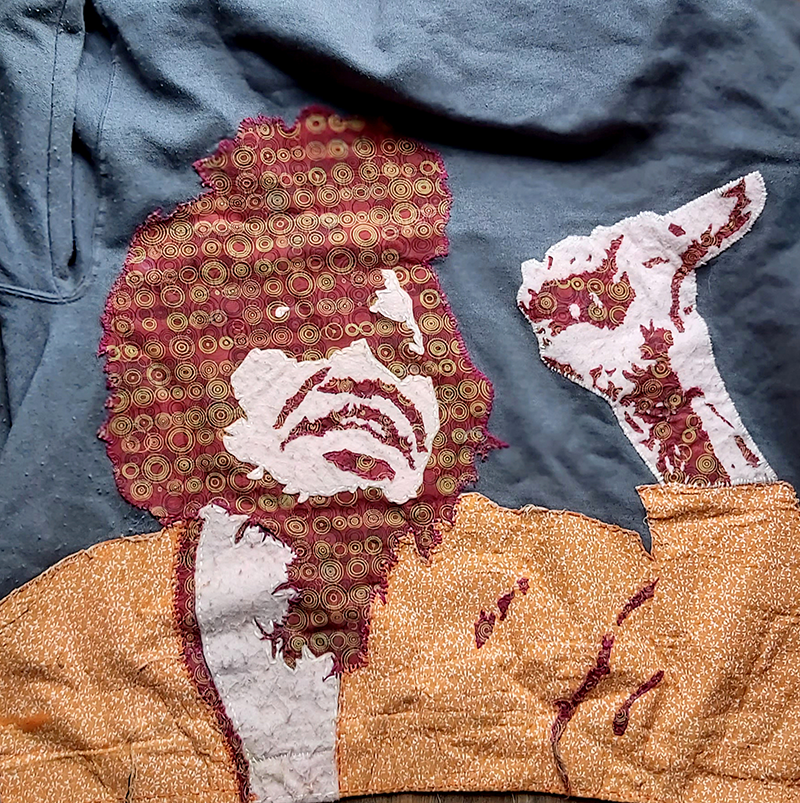
Hooded sweat shirt, by Fuzzy Mall
The weather was the catalyst for my work in appliqué. One winter’s day, I went out to my studio (a detached cinder block garage with a dirt floor) to find all of my paints and stains frozen solid. Unable to paint, I decided to make something for myself and hand-stitched a simple three-colour design of James Brown onto the back of a hooded sweatshirt. The piece was simple, but striking. I got a lot of positive feedback, so I began making more hoodies on the side. Over the next few years, I made about 50 different ones for friends. I was teaching myself new techniques, learning how to sew, tightening my craftsmanship, and incorporating more colours and layers along the way. Eventually, my interest in fabric superseded painting, and I’ve focussed solely on textiles for about six years now.
In 2016 my family moved from Pittsburgh, PA, to Hamilton, ON, a transition that granted me my first opportunity to make art full time. All of my work (mostly painting) was very personal in subject matter until then. I knew that if I was going to work in portraiture, I would have to meet some people, other than my wife and daughter. With that in mind, I went out and started up a conversation with a stranger, and talked with her about my new city. Then, I went home and quilted her portrait. A few weeks later, we met up again to show her the finished piece.
After that, I asked her to send me to the next person I should meet in town. I interviewed each new participant over a coffee or a beer, casually snapping photos while we chatted. Every person I met seemed kinder and sweeter than the last; all welcomed me into my new community.

Cole Gately, 17″ x 27″, 2017, by Fuzzy Mall
This work was my response to the disposable imagery that floods our brains via social media. I intended to slow down and make these ephemeral moments permanent, all while tapping into the history of both oil portraits and quilts, and their tendency to become family heirlooms. In this series, #facesofhamilton, I did 25 portraits over the next 15 months.
This project was my version of a portrait bootcamp. The intensive focus forced me to grow quickly and work decisively. I chose source photographs that would offer me new challenges, tried to push myself with each piece, and carried my newly-learned tricks into each sequential portrait.
After completing that series, I was ready to jump into something new. The next series, called Piecing Quiet, wrapped up earlier last year. I wanted to explore working on the entire body rather than just heads, shoulders, and occasionally hands. I was also feeling stifled by the square/ rectangular format. It became apparent what I had to do. I needed to focus on the figure and get rid of the background.
This format change led to many new challenges, including construction, scale, hanging, and archiving. It also allowed me to render clothing, tattoos, and objects with different textures and surfaces. Pieces focused on personal identity and diversity, depicting people of various ages, races, and genders. I captured people in action, in intimate settings, doing things they love to do.
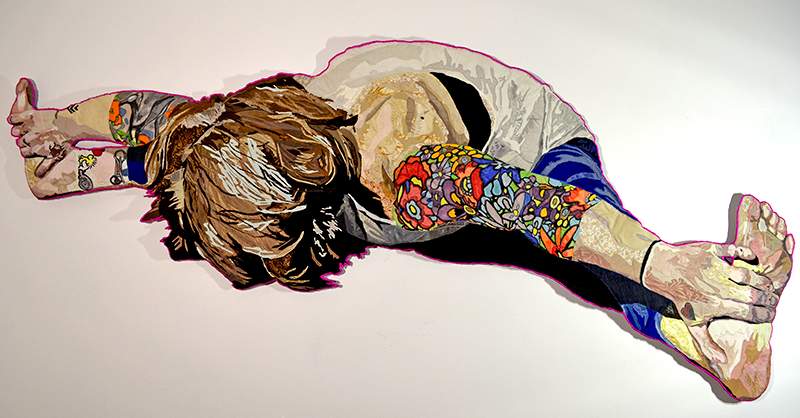
Amanda Pocha, 84″ x 42″, 2019, by Fuzzy Mall
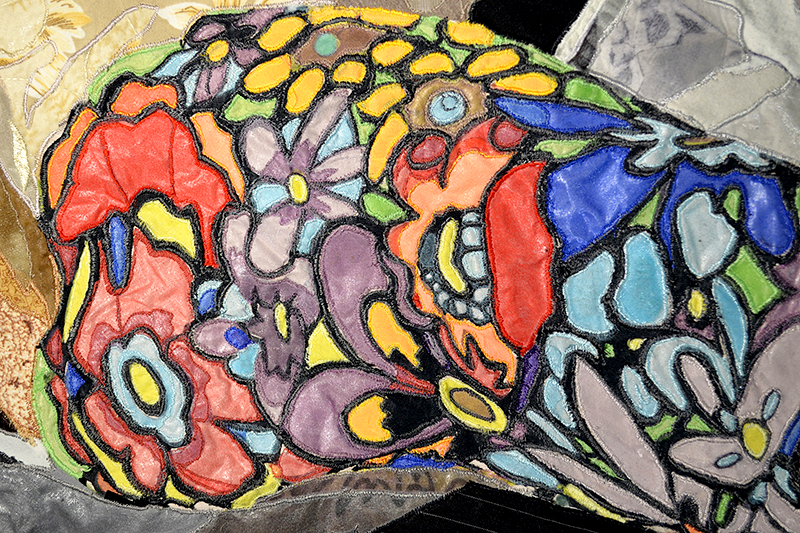
Amanda Pocha, detail, by Fuzzy Mall
The work was in response to the current media landscape, which is jarring and anxiety-inducing. As an American living in Canada, I’d been feeling helpless watching each news cycle. The work comments on the number of depressing news stories coming out of my home country. I feel sad, angry, frustrated, and ineffective. I know the stories of school shootings, corporate greed, decaying environment, and corrupt politicians won’t stop anytime soon. As a result, I can only focus on localized and momentary happiness. This series portrayed people doing simple things that bring them bliss, whether gardening, biking, yoga, or playing with a pet. More than ever, I need to see people enjoying life’s small moments. My pictures of protest are of people enjoying their lives.
The use of masks has permeated every culture throughout history, but never more so than in the past 18 months. COVID-19 forced the world to don these little cloth protectors. My newest body of work will investigate the physical masks we’ve all been using, and the psychological and digital masks we use daily to protect and hide our true selves. The nature of the internet allows users to hide behind screen names, filters, and Photoshop. We wear masks as armour, protecting ourselves from getting hurt. In a war zone, camouflage, helmets, and gas masks are implemented. The use of a physical mask can block someone from reading the emotions on a face. People implement psychological masks the same way, by exaggerating personality traits and emotions to hide the parts they want to keep from public view. By doing this, we close ourselves off emotionally from authentic relationships.
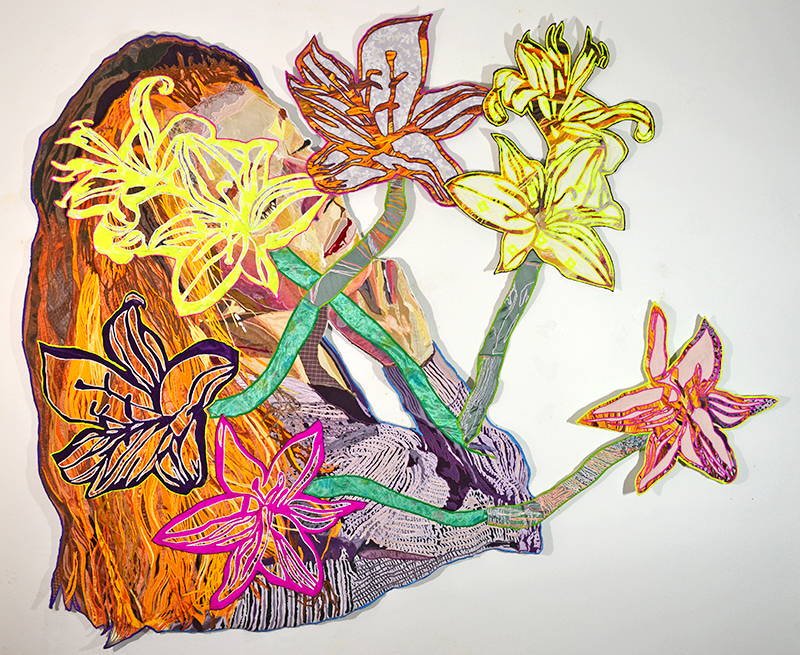
Emma Sincerbox2, by Fuzzy Mall
These works will be completed in multiple stages. The first version will consist of photo-realistic portraits of faces, six to eight feet in height. After documenting and archiving this step, I will cut into the work and peel back the surface to reveal the back side of the piece, suggesting the duality of a mask and what it protects. When merging the back and front of the work, new attention must be paid to the back side parts that will eventually be visible in the final version. To accomplish this, I will be rendering double-sided portraits. Negative space will be created by cutting and rearranging the surface. The shapes from the negative space will create new, surprising juxtapositions, and obfuscate the viewer from seeing an entire face. As we begin to come out of this pandemic, are we comfortable seeing an unobstructed face? Or do we want to continue to see them covered up?
These won’t be the first pieces that I’ve cut into (or some think, ruined). I cut up previous portraits into concentric circles and reconstituted them into new pieces in my Kill Your Darlings series. This process was treated as a formal exercise that catalyzed my work moving forward, permitting me to destroy former works to recreate them anew. I find the destroying and reinterpreting of older works liberating. It’s a practice that I fully expect to continue throughout my career. I want to allow my portraits to disappear under layers of new works and ideas eventually, all while holding the histories and symbolism of the past.
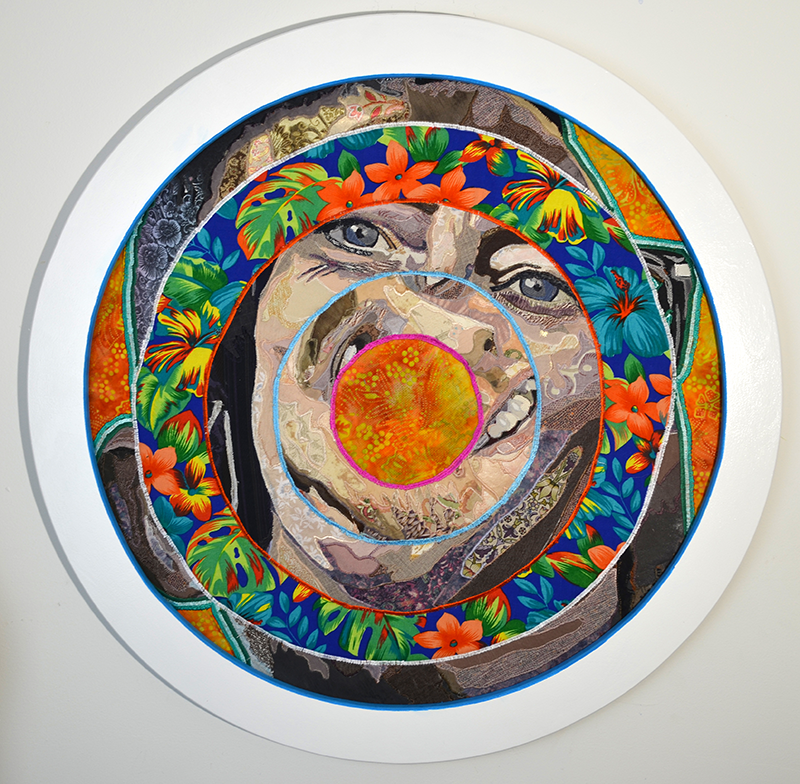
Kill Your Darlings #4
I mostly use reclaimed textiles in my work. Now I’m reclaiming the reclaimed.
The average American discards 70 lbs of clothing annually; 81 lbs for Canadians (we have more boots). Globally, 92 million tons of textiles end up in a landfill every year. According to a story by the BBC, that’s the equivalent of a garbage-truck full, every second, all year long. This article stuck with me, and is one of the main reasons I try to use as many reclaimed textiles in my work as possible. Sure, I still rummage through the clearance section of my fabric stores from time to time, but I estimate that over 90% of everything I use is clothing and housewares sourced from a thrift store, or has been donated to me by friends.
As textile artists, I feel strongly that all of us should incorporate this into our practice as much as possible. Besides helping the environment in a small way, I have found that my work has become more dynamic because of it. I can’t rely on using the identical prints or colours from a bolt that I bought. Once a particular t-shirt or dress has been cut up, it’s gone. I have to constantly come up with new solutions and interpretations of my palette. Aesthetically, I prefer using reclaimed textiles as well. They have a history unto themselves, washed, worn … much like the subjects I am depicting.
Fuzzy’s work will be exhibited at Excellence in Quilts at the Virginia Quilt museum, and at FiberArt International in Pittsburgh. Watch for updates at quiltedportrait.net and @quiltedportrait on Instagram.

